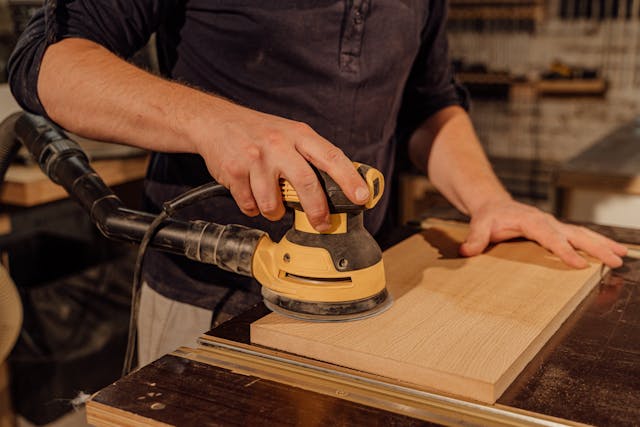Sanding is an essential step in woodworking that elevates your projects from rough to refined, bringing out the natural beauty of wood while preparing it for finishing. However, when it comes to sanding intricate wood details, the process demands precision, patience, and the right tools. Whether you’re restoring antique furniture, crafting ornate designs, or preparing delicate carvings for paint or stain, knowing how to sand intricate wood details effectively can make all the difference in achieving professional-quality results.
Intricate wood details require a careful approach to avoid damaging the delicate patterns or over-sanding specific areas. This guide explores the techniques, tools, and tips that will help you confidently tackle even the most challenging projects. By the end, you’ll be equipped with a comprehensive understanding of how to sand intricate wood details with ease and finesse.
The Importance of Proper Preparation
Preparation is key when you begin to sand intricate wood details. This step ensures that the surface is clean, stable, and ready for sanding. Start by thoroughly cleaning the wood to remove dust, grime, or residue that may interfere with the sanding process. If you’re working on old furniture or salvaged wood, inspect for nails, staples, or loose joints.
Proper preparation not only protects the wood but also prolongs the lifespan of your sanding tools. Use compressed air or a soft-bristle brush to clean hard-to-reach areas before you begin sanding intricate wood details.
Selecting the Right Sandpaper for Intricate Wood Details
Choosing the correct sandpaper is vital when sanding intricate wood details. Coarser grits like 80 or 100 are suitable for initial sanding, while finer grits like 220 or 320 are ideal for finishing. The type of sandpaper you select also matters; for intricate designs, flexible and durable options like garnet or aluminum oxide sandpaper perform best.
Using sanding sponges or sheets that can conform to curves and tight spaces is an excellent choice for tackling carvings and complex shapes. The right sandpaper not only ensures a smoother finish but also reduces the risk of damaging delicate wood details.
Essential Tools for Sanding Intricate Wood Details
Specialized tools make it easier to sand intricate wood details efficiently and precisely. While traditional sanding blocks are helpful for flat surfaces, they may not be ideal for tight spaces and complex designs.
Some of the best tools for intricate work include:
- Detail Sanders: Compact and designed for precision, these are excellent for corners and edges.
- Rotary Tools: Perfect for reaching narrow crevices or adding extra detail.
- Hand Files: Great for small grooves and carvings that require a delicate touch.
- Flexible Sanding Pads: Ideal for curved and uneven surfaces.
Investing in quality tools ensures you achieve the best results without compromising the integrity of the wood.
Techniques for Sanding Carvings and Ornate Designs
When sanding intricate wood details, technique is just as important as tools. Begin by identifying the grain direction and always sand along it to avoid scratches or damage. Use light, even pressure to maintain the original design and shape.
For carvings or ornate patterns, consider wrapping sandpaper around a dowel, pencil, or even your finger to access tight spots. For delicate areas, a sanding sponge can help you maintain control and avoid over-sanding. Always finish with finer grit sandpaper for a polished look.
Maintaining the Integrity of Intricate Details
Preserving the original detail is a crucial part of sanding intricate wood designs. Over-sanding can ruin fine carvings, grooves, or patterns, diminishing the beauty of the piece. To avoid this, take frequent breaks to assess your progress and avoid using excessive force.
If you’re working on an antique or valuable item, test your sanding technique on an inconspicuous area first. Using slow, deliberate movements ensures that the intricate details remain intact while achieving a smooth finish.
Dealing with Hard-to-Reach Areas
Hard-to-reach areas pose a significant challenge when sanding intricate wood details. Specialized tools like rotary sanders, flexible sanding pads, or pointed hand files can make the task more manageable.
For areas that are exceptionally tight or narrow, you may need to switch to manual tools or use a precision rotary attachment for your power tool. Always approach these spots with patience and care, as they are often the most vulnerable to over-sanding or damage.
Finishing Techniques to Enhance Intricate Wood Details
After sanding intricate wood details, the finishing process is equally important. Whether you’re applying paint, stain, or varnish, the goal is to enhance the wood’s natural beauty while protecting it.
Before applying any finish, clean the surface thoroughly to remove residual dust. A tack cloth or vacuum can be particularly effective for intricate details. When staining or painting, use a small brush to reach grooves and carvings, ensuring even coverage without pooling.
Common Mistakes to Avoid When Sanding Intricate Wood Details
Even experienced woodworkers can make mistakes when sanding intricate wood details. Avoid these common pitfalls to achieve professional results:
- Using the Wrong Grit: Starting with sandpaper that’s too coarse can leave deep scratches.
- Over-Sanding: Excessive sanding can damage fine details.
- Skipping Progress Checks: Always pause to assess your work and ensure consistency.
Expert Tips for Sanding Intricate Wood Details
To sand intricate wood details effectively, follow these expert tips:
- Start Slow: Begin with a light touch and gradually increase pressure as needed.
- Use Guides: A flexible sanding block or pad can help maintain even pressure.
- Practice Patience: Rushing the process increases the risk of errors or damage.
Conclusion: Perfecting the Craft of Sanding Intricate Wood Details
Mastering the art of sanding intricate wood details is a rewarding skill that elevates the quality of your woodworking projects. With the right tools, techniques, and attention to detail, even the most complex carvings can achieve a flawless finish. From choosing the perfect sandpaper to navigating tight spaces and applying finishes, every step contributes to the beauty and durability of your work.
By understanding the nuances of how to sand intricate wood details, you’ll gain the confidence and expertise needed to tackle any woodworking challenge. Whether restoring a treasured heirloom or crafting a new piece, the results will speak for themselves—proof of your dedication and craftsmanship.





